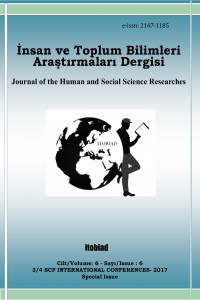Analysis of Comparative Advantages in Exports of Turkey and Azerbaijan on the basis of Technology Intensity
Abstract
Turkey’sforeigntradestrategy
in recentyears, primarily has toreducethetradedeficit
(andcurrentaccountdeficit) byincreasingtheexport. However,
decreasingconcentration in export has beenrevealed as an
importantgoalbyeconomypolicymakers. Because, decreasingconcentration
(increasingdiversification) in exportplays an important role
toachievethecompetitiveadvantage of Turkey in theglobaleconomy.
Inthisstudycoveringtheyears 2000-2014, thelevel of productand market
concentration in Turkey’sexportwasdeterminedbyusingConcentrationRatio of
Commerce andGini-Hirschman Index. Accordingtotheanalysis, it has
beenrevealedthatproductand market concentrationshavedecreased.
References
- 2017 Index of Freedom, erişim tarihi: 29.09.2017, http://www.heritage.org/index/country/azerbaijan#.
- Balassa, B. andNoland, M. (1989).RevealedComparative Advantage in Japan andthe United States, Journal of International Economic Integration. 4(2). 8-22.
- Beningo, S. (2005).TradeandTransportationBetweenthe United StatesandChina,andBetweenthe United StatesandIndia, 2006 Conference of theSociety of GovernmentEconomists, Washington.
- Coxhead, I. (2007). A New Resource Curse? Impacts of China’sBoom on Comparative Advantage and Resource Dependence in SoutheastAsia, World Development, Vol:35, No:7.
- Demir Şeker, S. (2011). Türkiye’nin İnsani Gelişme Endeksi ve Endeks Sıralamasının Analizi, T. C. Kalkınma Bakanlığı Yayını, No. 2828, erişim tarihi:02.10.2017,
- http://www3.kalkinma.gov.tr/DocObjects/View/13562/Turkiyenin_Insani_Gelisme_EndeksiveEndeksSiralamasininAnalizi.pdf.
- Erkan, B. ve Kazım S. (2014). Comparative Analysis of theCompetitiveness in theExport of Science-BasedGoodsRegardingTurkeyandthe EU+13 Countries, International Journal of Business andSocialScience, Center forPromotingIdeas, USA, Vol:5, Issue: 8(1).
- Faustino, H. (2008). Intra-IndustryTradeandRevealedComparative Advantage: An Inverted-U Relationship, SOCIUS WorkingPaper. No:03. 7. 1-13.
- Global Competitiveness Index (2016-2017), erişim tarihi: 27.09.2017, http://reports.weforum.org/global-competitiveness-index/#topic=data.
- Hinloopen, J. (2001). On theEmpirical Distribution of theBalassa Index, Review of World Economics, 137(1). 13. 1-49.
- Human Development Index anditscomponents, erişim tarihi: 30.09.2017, http://hdr.undp.org/en/composite/HDI.
- Human Development Index, 1990-2015; erişim tarihi: 27.09.2017, http://hdr.undp.org/en/data.
- Human Development Report 2016, erişim tarihi: 30.09.2017, http://hdr.undp.org/sites/all/themes/hdr_theme/country-notes/AZE.pdf. Human Development Report 2016, erişim tarihi: 30.09.2017, http://hdr.undp.org/sites/all/themes/hdr_theme/country-notes/TUR.pdf.
- Kara, O. ve Erkan, B. (2012). Türkiye’nin Emek Yoğun Mal İhracatındaki Karşılaştırmalı Üstünlüklerin Makro Ekonomik Büyüklüklerle İlişkisi, Abant İzzet Baysal Üniversitesi İİBF Ekonomik ve Sosyal Araştırmalar Dergisi, Cilt:7, Yıl:7, Sayı:1.
- Küçükkiremitçi, O. (2006). Sanayi Sektörünün Dış Ticaret Performansının Rekabet Gücüne Göre Değerlendirilmesi (1995-2005 Dönemi),(Sunum: T.C. İnönü Üniversitesi İ.İ.B.F. Ulusal Bağımsızlık İçin Türkiye İktisat Politikaları Kurultayı, Malatya.
- Methodology of 2017 Index of EconomicFreedom, erişim tarihi: 30.09.2017, http://www.heritage.org/index/book/methodology.
- Rivlin, P. (2000).TradePotential in theMiddle East: SomeOptimisticFindings, Middle East Review of International Affairs, 4(1). 60. 56-66.
- Şeker, S. D. (2017). Türkiye’nin İnsani Gelişme Endeksi ve Endeks Sıralamasının Analizi, T. C. Kalkınma Bakanlığı Yayını, No. 2828, http://www3.kalkinma.gov.tr/DocObjects/View/13562/Turkiyenin_Insani_Gelisme_EndeksiveEndeksSiralamasininAnalizi.pdf.
- Ünlü, B. C. (2017). Küresel Rekabet Raporu (2016-2017) İnovasyon Bileşeni Kapsamında Türkiye Değerlendirmesi, erişim tarihi: 15.10.2017, http://anahtar.sanayi.gov.tr/tr/news/kuresel-rekabet-raporu-2016-2017-inovasyon-bileseni-kapsaminda-turkiye-degerlendirmesi/9446
Türkiye ve Azerbaycan’ın İhracatındaki Karşılaştırmalı Üstünlüklerin Teknoloji Yoğunluğu Bazında Analizi
Abstract
Bu çalışmada, Türkiye ve Azerbaycan’ın ihracatındaki
teknoloji yoğunluklarının ölçülmesi ve karşılaştırmalı üstünlüklerinin
analizinin yapılması amaçlanmıştır. Bu bağlamda, Standart Uluslararası Ticaret
Sınıflandırması kullanılarak, 2000-2015 döneminde, söz konusu ülkelerin ar-ge
bazlı ürün ihracatındaki açıklanmış karşılaştırmalı üstünlük katsayıları
hesaplanmıştır. Yapılan analizler sonucunda elde edilen skorlar, her iki
ülkenin de küresel piyasalarda ar-ge bazlı ürün ihracatında karşılaştırmalı
üstünlüklerinin bulunmadığını ortaya koymaktadır.
References
- 2017 Index of Freedom, erişim tarihi: 29.09.2017, http://www.heritage.org/index/country/azerbaijan#.
- Balassa, B. andNoland, M. (1989).RevealedComparative Advantage in Japan andthe United States, Journal of International Economic Integration. 4(2). 8-22.
- Beningo, S. (2005).TradeandTransportationBetweenthe United StatesandChina,andBetweenthe United StatesandIndia, 2006 Conference of theSociety of GovernmentEconomists, Washington.
- Coxhead, I. (2007). A New Resource Curse? Impacts of China’sBoom on Comparative Advantage and Resource Dependence in SoutheastAsia, World Development, Vol:35, No:7.
- Demir Şeker, S. (2011). Türkiye’nin İnsani Gelişme Endeksi ve Endeks Sıralamasının Analizi, T. C. Kalkınma Bakanlığı Yayını, No. 2828, erişim tarihi:02.10.2017,
- http://www3.kalkinma.gov.tr/DocObjects/View/13562/Turkiyenin_Insani_Gelisme_EndeksiveEndeksSiralamasininAnalizi.pdf.
- Erkan, B. ve Kazım S. (2014). Comparative Analysis of theCompetitiveness in theExport of Science-BasedGoodsRegardingTurkeyandthe EU+13 Countries, International Journal of Business andSocialScience, Center forPromotingIdeas, USA, Vol:5, Issue: 8(1).
- Faustino, H. (2008). Intra-IndustryTradeandRevealedComparative Advantage: An Inverted-U Relationship, SOCIUS WorkingPaper. No:03. 7. 1-13.
- Global Competitiveness Index (2016-2017), erişim tarihi: 27.09.2017, http://reports.weforum.org/global-competitiveness-index/#topic=data.
- Hinloopen, J. (2001). On theEmpirical Distribution of theBalassa Index, Review of World Economics, 137(1). 13. 1-49.
- Human Development Index anditscomponents, erişim tarihi: 30.09.2017, http://hdr.undp.org/en/composite/HDI.
- Human Development Index, 1990-2015; erişim tarihi: 27.09.2017, http://hdr.undp.org/en/data.
- Human Development Report 2016, erişim tarihi: 30.09.2017, http://hdr.undp.org/sites/all/themes/hdr_theme/country-notes/AZE.pdf. Human Development Report 2016, erişim tarihi: 30.09.2017, http://hdr.undp.org/sites/all/themes/hdr_theme/country-notes/TUR.pdf.
- Kara, O. ve Erkan, B. (2012). Türkiye’nin Emek Yoğun Mal İhracatındaki Karşılaştırmalı Üstünlüklerin Makro Ekonomik Büyüklüklerle İlişkisi, Abant İzzet Baysal Üniversitesi İİBF Ekonomik ve Sosyal Araştırmalar Dergisi, Cilt:7, Yıl:7, Sayı:1.
- Küçükkiremitçi, O. (2006). Sanayi Sektörünün Dış Ticaret Performansının Rekabet Gücüne Göre Değerlendirilmesi (1995-2005 Dönemi),(Sunum: T.C. İnönü Üniversitesi İ.İ.B.F. Ulusal Bağımsızlık İçin Türkiye İktisat Politikaları Kurultayı, Malatya.
- Methodology of 2017 Index of EconomicFreedom, erişim tarihi: 30.09.2017, http://www.heritage.org/index/book/methodology.
- Rivlin, P. (2000).TradePotential in theMiddle East: SomeOptimisticFindings, Middle East Review of International Affairs, 4(1). 60. 56-66.
- Şeker, S. D. (2017). Türkiye’nin İnsani Gelişme Endeksi ve Endeks Sıralamasının Analizi, T. C. Kalkınma Bakanlığı Yayını, No. 2828, http://www3.kalkinma.gov.tr/DocObjects/View/13562/Turkiyenin_Insani_Gelisme_EndeksiveEndeksSiralamasininAnalizi.pdf.
- Ünlü, B. C. (2017). Küresel Rekabet Raporu (2016-2017) İnovasyon Bileşeni Kapsamında Türkiye Değerlendirmesi, erişim tarihi: 15.10.2017, http://anahtar.sanayi.gov.tr/tr/news/kuresel-rekabet-raporu-2016-2017-inovasyon-bileseni-kapsaminda-turkiye-degerlendirmesi/9446
Details
| Journal Section | Articles |
|---|---|
| Authors | |
| Publication Date | November 19, 2017 |
| Published in Issue | Year 2017 Volume: 6 Issue: 6 |


